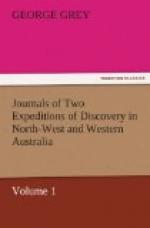St. George’s Basin is a noble sheet of water some ten or twelve miles across. On its southern side deep inlets run up into a low and marshy country, leading to fertile districts, and the main object of my present excursion was to endeavour to identify these inlets with some I had seen on my first trip to the southward.
Scenery and thunderstorm.
On the northern bank lofty mountains, crowned with castellated summits, rear their sterile heads over the broad waters, and fling their giant shadows on the bosom of the basin, forming a scene of surpassing beauty.
We had entered the more contracted channel of the river, when there came on a tremendous squall of wind, rain, thunder, and most vivid lightning. The pealing echoes of the thunder as they bounded from height to height and from cliff to cliff was awfully magnificent; whilst the rugged mountains which had just before looked golden in the bright light of the setting sun were now shrouded in gloomy mists, and capped with dark clouds from which issued incessant and dazzling flashes of lightning.
During this grand and terrific elemental convulsion our little boat was driven powerless before the blast. The impenetrable forests of mangroves which clothed the riverbanks obliging us to run far up the stream until at last a convenient opening enabled us to land upon the southern shore.
Delusive appearance on the rocks.
We had not long landed when the rain ceased and, as we found several natural caverns in the rock and plenty of dead mangrove trees, we proceeded to make ourselves comfortable for the night; but the men soon reported that they saw the smoke of a native fire close to us, and Captain Browse and myself, under the conviction that such was the case, darted with Mr. Walker to endeavour to gain an interview. But, as we proceeded over the rocks, the smoke appeared gradually to retire, always keeping about the same distance from us: and we at last ascertained that what had appeared to us to be smoke was nothing but the rising vapour occasioned by the cold rain falling on sandstone rocks, which had during the whole day been exposed to the burning rays of a tropical sun.
We had now become so much accustomed to sleeping without any covering, and upon hard rocks, that we should not have minded our exposure had it not been for the rain which fell during the night and beat in under the rocks, beneath which we had crept for shelter. The cold air of the morning awoke us long before daylight; and Mr. Walker and myself, having explored the country to the southward and climbed a high hill from which we had an extensive view, we started on our return to the schooner. In proceeding down the river we landed on an island, situate at the south-eastern extremity of St. George’s Basin, just where the river runs into it. The presence of large dead trees on this island, which had evidently been swept down the river in the time of floods and washed up far above the usual water-mark, showed that Prince Regent’s River is subject to the same sudden inundations as all other rivers in Australia which I have seen. During our passage down the river we saw no extent of good land in any one place.




